Single lane traffic lights
Introduction
By this point of your training (P.O.M) moving off from the side of the road and stopping on the left and right hand side of the road (smoothly), gear changes, clutch control, hill including angle starts and busier junctions should now becoming independent, this includes anticipation, awareness and planning with the road ahead, behind, reacting safely to pedestrians, cyclists while driving, so it’s now to look at dealing with single lane traffic lights (especially turning right).
This briefing could be taught before or after roundabout's however you will be giving your new lesson topic for your next driving lesson at the end of your lesson from your instructor.
Agreed lesson is covering :-
On this lesson you have agreed with your instructor you will be working on single lane traffic lights.
You will be using and incorporating the L.A.D.A and hazard routine's during this lesson, on the way to the training location you be from now assessed on your driving skills from previous briefs:-
L.A.D.A & M.S.P.S.G routines on junctions and crossroads you approach
Nearside to near side and offside to off side then crossing
Two second gap. hold back position
Meeting, overtaking, adequate clearance when overtaking stationary & slow moving vehicles
Awareness and planning
Traffic calming measures
Hill/angle starts
Busier junctions
Approaching and negotiating single, multi lane and mini roundabouts
Agree level of instruction
Intervention
Agree on what part of the lesson is going to be a instructor-lead-lesson and client-centred-lesson and if it is client-lead agree if the instructor has to intervein verbally and take control of the training vehicle by ether using the dual control, verbally or take the wheel the lesson plan may need to be changed until the fault is fixed.
F.I.S.H
- Fault
- Implication
- Solution
- Help
Lesson aims and strategies
Todays briefing will be using the L. A. D. A and M.S.P.S.G routine's on the approach different mini lane roundabouts and work on approaching speed and timing of gaps on roundabouts. These routine's will be broken down to help you develop your skill to organise your lane positioning, negotiate gaps when approaching different types of single lane roundabout.
Risk responsibility objective's
You and your instructor will agree lesson plan support to ether:-
- Full talk through
- Prompt
- Independent
This is important to ensure that the instructor and student understands who has the main responsibility on the control of the training vehicle on the set lesson plan.
Your level of instruction will be given by your instructor to a level to suit you from full talk through then reducing your support to either prompt or independent.
Sigle lane traffic lights brief
Planning approaching traffic lights
On the approach to a traffic lights your job as a student is to plan and make progress at a set of traffic lights. Why? just image racing up to a red traffic light and it immediately changes amber to green and you are not prepared to go! That is on the DL25 marking sheet Junctions, Progress or Response to signs / signals.
You should have recognised and reacted correctly to signs and signals on the road. This included:
- road signs
- road markings
- traffic lights
- traffic controllers
- other road users
Examples of faults
Some of the most common faults for this area include:
- taking up space meant for cyclists when stopping at a red traffic light
- reacting late or not at all to a speed limit change sign
- not stopping at a compulsory stop sign
- driving in a bus lane when sign says you should not
- driving in an incorrect lane that was clearly marked
Your examiner may have explained the specific details of any faults you made.
How you can improve in this area
If you made faults in this area during your test, or if you want to improve in this area, you should:
- check The Highway Code’s sections on traffic signs, road markings and signals by authorised persons
- read ‘Know Your Traffic Signs’
- read section 6 of ‘The Official DVSA Guide to Driving: the
Essential Skills’ (2022 edition)
If you need to rebook the test, spend time practising and improving this skill with your driving instructor or supervising driver. Ask them to quiz you on the signs and signals you will come across on the road.
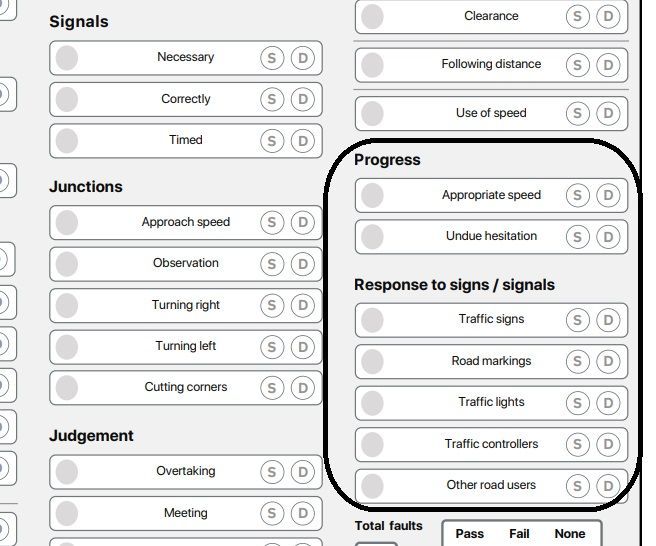
Forward planning
Looking, Assessing, deciding and acting is needed at every junction, roundabout and traffic light system, but the difference at a set of traffic lights is the T junction or crossroads is controlled by traffic lights. On the approach look for clues on who will be next in the traffic light sequence... Are you approaching a red traffic light? Have you assessed if the adjacent road has vehicles passing the mouth of your junction/crossroad then the traffic flow stops... This could mean your traffic light could change to green next. Always react accordingly with your approaching speed and try to slow and flow when the traffic light sequence changes.
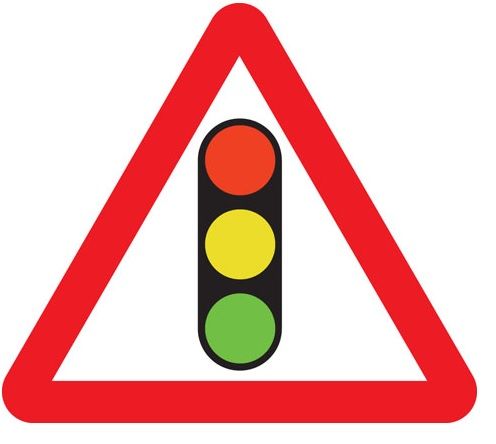
Sequence at a single lane traffic lights
The sequence of a traffic from red is:-
- Red
- Red/amber
- Green
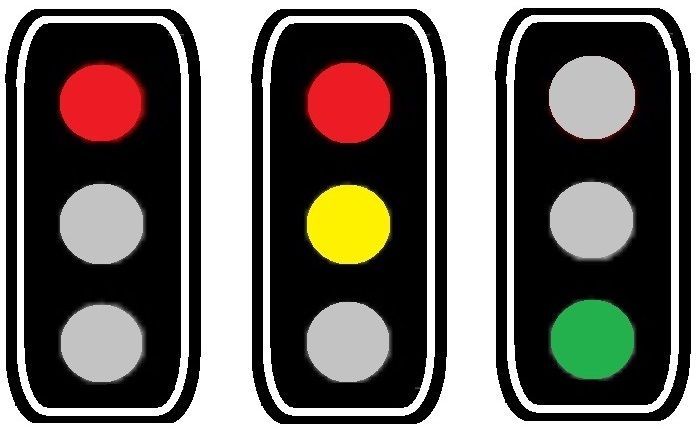
The sequence of traffic lights from green is:-
- Green
- Amber
- Red
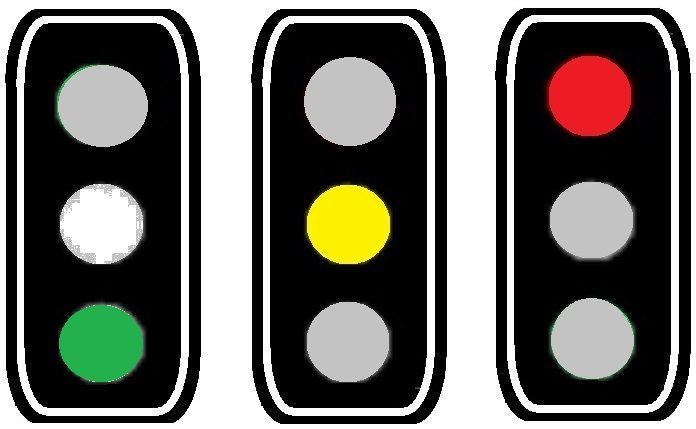
There is no green filer system on a single lane traffic light
(this is covered on the next lesson brief)
Question
If you see an amber light what colour light will be next?
Question
If you see an red light what colour light will be next?

The lights break down
If you see this sign when approaching traffic lights, this is letting you know the traffic lights have broken and nobody has priority at the junction. Slow down and treat it as an unmarked Crossroads (No one has priority) and give-way to your right.
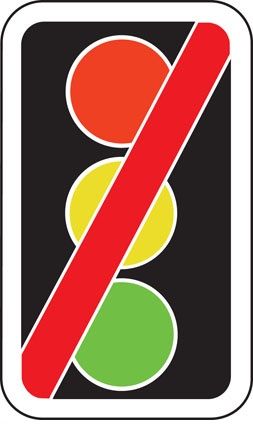
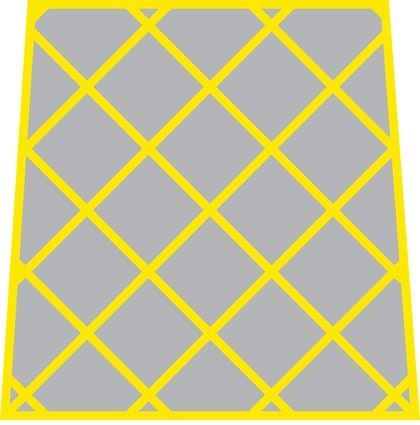

Right Turns at Traffic Light
Turning right at traffic light (crossroads) can be a complex when on a busy junction, the highway code rules will help you understand the proper positioning and why when turning right.
When you intend to turn right you have to giving way to the main road approaching that is travelling ahead and passing you, the same is at junctions and crossroads that are controlled by traffic lights. You must also be aware of pedestrians crossing the road you are turning into, so watch out for pedestrians who may be rushing across the road you intend to cross into and be prepared to give way to pedestrians who are crossing improperly.
Which is the correct method Offside or Nearside
Offside to Offside method
This method involves positioning your car so that your right side is aligned with the right side of the car facing you from the opposite direction. This allows both drivers to see past each other, improving visibility and safety. This method is generally less common but safer, it is employed mainly at very large junctions where you are crossing multiple lanes prior to turning right, or at junctions that aren’t quite suitable for the other method.
Nearside to Nearside method
Driver mainly use Nearside to Nearside method at traffic lights when turning right but unfortunately this has it’s issues. The main issue is the reduction of visibility of what is behind the approaching vehicle (this is where early observation are needed to look and minimise any risks).
The choice between offside to offside and nearside to nearside can depend on the layout of the junction and personal preference. You will find yourself with in time to alter the method of turn depending on where you live, very rarely using the safer offside to offside method.
Green filter
Some traffic lights have a filter light for right turns. When the red light is on and the filter light is green it indicates it is safe to right turn safely without giving way to oncoming traffic. Continue to maintain observations at the green filter arrow as the traffic lights may chance from the green filter to turn right to the main road now getting a green light to go ahead and left and you will need to wait at the point of turn in the junction and only proceed once it is safe to cross or the lights have gone back to red.
Positioning in the Junction
Look for any white right turning arrows on the road as these markings are there to guide you into the correct position.
Please note: vehicle may run through a red light on the opposite side so always maintain observation throughout the turn (this is discussed more on the multi lane traffic light brief).
No green filter
When a traffic lights has no Filter Light you must wait in the correct position until it is safe to turn, giving way to oncoming traffic and pedestrians. Remember if you have time to walk across the road you should have time to drive across the road.
Yellow Box Junction
These have criss-cross yellow lines painted on the road. You
MUST NOT
enter the box until your exit road or lane is clear. However, you may enter the box and wait when you want to turn right, and are only stopped from doing so by oncoming traffic, or by other vehicles waiting to turn right. At signalled roundabouts you
MUST NOT
enter the box unless you can cross over it completely without stopping.
Correct P.O.T
When turning right at junction can become confusing of other drivers when they are also wanting to turn right. The reason for this is that all drivers will ether do offside to offside or nearside to nearside. Your instructor will guide you on the best P.O.T to negotiate as different traffic lights and crossroads systems.
The correct point of turn will allow other vehicles to turn right when you are waiting for a gap with approaching traffic.

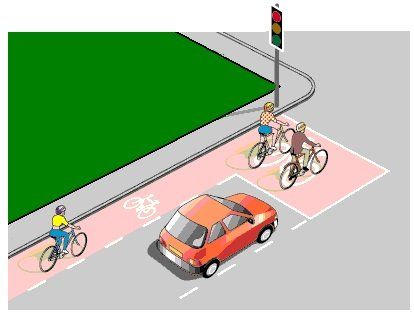
Teaching & Learning Strategies
Like mentioned earlier every student is induvial and each and everyone of you will progress at different rates so driving will adapt their lesson plan to help you achieve your driving goals.
- Your driving instructor will adapt their teaching style to suite your ability and ability
- Your driving instructor will continue to encourage you on your lesson and analyse any problems made and allow you to take responsibility for your own learning goals by giving you technical information to improve your techniques. Your technical feed back from your instructor will be ether given on the move or if feel needed by pulling you up on the side of the road somewhere safe, legal and convenient.
Rote learning (WikipediA)
Rote learning is a memorization technique based on repetition. The method rests on the premise that the recall of repeated material becomes faster the more one repeats it. Some of the alternatives to rote learning include meaningful learning, associative learning, spaced repetition and active learning.
At the end of your lesson
At the end of your lesson you will have a debrief with your instructor giving you the opportunity to reflect on your performance on your lesson then you can set up new goals for your next driving lesson.
This will also give you the opportunity to research any new topics that will be brought into on your next agreed lesson. So remember your instructor is there to HELP you, so on your driving lesson if you have any uncertainties or need anything rewording or recapping to make things any clearer, just ask.

